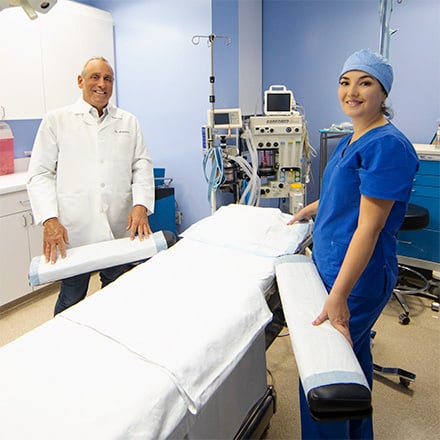As we age, skin gradually loses collagen, the natural protein that gives skin its firmness and flexibility. When this happens, facial features may lose their youthful proportions, changing the overall character of our look.
Experienced Long Island plastic surgeon Lloyd D. Landsman, MD knows that restoring facial balance requires adding volume to areas that have lost fullness, and reducing areas that have stretched, sagged or developed folds. Below, he outlines surgical and non-invasive solutions that will create the appearance of higher cheekbones to slim your facial profile.
Injectable Options
Dermal fillers offer the most convenient way to add volume to cheeks. Each year new varieties become available, providing an ever-widening array of choices to patients. For cheek augmentation, Dr. Landsman recommends Juvederm Voluma, Restylane Lyft, Restylane-L or Radiesse.
Juvederm Voluma was the first dermal filler approved by the U.S. Food and Drug Administration for adding volume to cheeks. Injections soften contours and create the illusion of higher cheekbones. Restylane Lyft restores cheek volume with a gel that is thicker than other dermal fillers. The plumping effect also smooths the skin and erases creases.
Restylane-L is ideal for all types of sunken facial areas, and is especially effective at filling the troughs that sometimes form between the lower eyelids and cheeks. Radiesse is often recommended for adding volume to either cheeks or the chin.
Fat Transfer
A permanent way to achieve a slimmer facial look is microfat transfer, a convenient alternative to facelift and other more invasive surgical techniques. This technique improves aesthetic balance and shapes a lifted appearance in the cheeks by injecting tiny amounts of fat below the rim of the eyes.
In this procedure, Dr. Landsman uses a small-particle version of your body’s natural fat and injects small amounts of these cells under the skin in strategic areas. The cells are prepared using special devices that filter and break down the fat that has been harvested from elsewhere in the body, using a liposuction technique.
Although facial fat transfers have been performed for decades, today’s technique is far more advanced and effective. Without microfat, injections of body fat sometimes created lumps and puffiness in the face. In addition, the inexactitude of surgical instruments made precise targeting of facial areas difficult.
Unlike temporary dermal fillers, fat transfer is a long-lasting solution. The injected fat cells become an integral part of your subdermal face. As long as they have access to the blood supply, these living cells will thrive wherever they have been placed.
Depending on a number of factors, approximately one third of fat cells will be absorbed by the body after the microfat transfer procedure; the others will adjust to their new location perfectly and become permanent fillers in the target areas. Based on your reabsorption rate, you may require a follow-up session in six months to fine-tune the volume and shape of your new, rejuvenated facial profile.
For more information on facial plastic surgery, call or email to schedule an appointment in the Smithtown, Long Island office of board-certified plastic surgeon Lloyd D. Landsman, MD.











